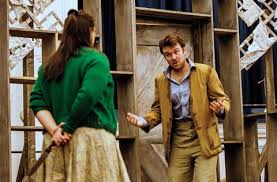Devonshire Park Theatre, Eastbourne, Sunday 2 April 2017
New Sussex Opera have done so much good work over the years, and given us so many splendid evenings of opera, it is a shame not to be more enthusiastic about this most recent production. The fault is not theirs – unless one blames them for choosing it in the first place – but Delius’ folk tale really does not carry enough dramatic weight to keep the audience engaged across the six scenes. That the final two scenes come slightly more alive, and include the finest music of the piece with the Walk to the Paradise Garden, does little to make up for the lack of musical variety or characterisation in the first four.
Thankfully there is some fine playing from the ensemble under Lee Reynolds and the chorus makes an impression in the little it has to do. Luke Sinclair sings Sali with a sense of style and frequent lyrical beauty, but his presence too often seemed detached from the reality around him. Kirsty Taylor-Stokes’ Vrenchen was equally positive vocally but her costume and demeanour too often made her look simplistic rather than naïve. This may have been an idea of the director Susannah Waters to play them like Hansel and Gretel rather than Pelleas and Melisande, but if so it did not really fit with the stark utilitarianism of the setting. The fathers were strongly cast with Robert Gildon and Geoffrey Moses bringing tension to the opening minutes but this is lost in the miasma Delius creates around them, draining the potential tension of the relationship.
Ian Beadle’s Dark Fiddler – here played like the Sandman and as such giving yet another echo of Hansel – was strongly sung and as credible as the score would allow.
There was an excellent programme – not always the case with smaller companies – from which I note that they will bring us Gluck’s Orfeo next year. Now that will be worth going to – no problem with that being a masterpiece.


